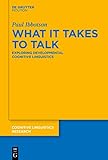What it Takes to Talk : Exploring Developmental Cognitive Linguistics / Paul Ibbotson.
Material type: TextSeries: Cognitive Linguistics Research [CLR] ; 64Publisher: Berlin ; Boston : De Gruyter Mouton, [2020]Copyright date: ©2020Description: 1 online resource (X, 224 p.)Content type:
TextSeries: Cognitive Linguistics Research [CLR] ; 64Publisher: Berlin ; Boston : De Gruyter Mouton, [2020]Copyright date: ©2020Description: 1 online resource (X, 224 p.)Content type: - 9783110644418
- 9783110644500
- 9783110647914
- 400
- online - DeGruyter
- Issued also in print.
| Item type | Current library | Call number | URL | Status | Notes | Barcode | |
|---|---|---|---|---|---|---|---|
 eBook
eBook
|
Biblioteca "Angelicum" Pont. Univ. S.Tommaso d'Aquino Nuvola online | online - DeGruyter (Browse shelf(Opens below)) | Online access | Not for loan (Accesso limitato) | Accesso per gli utenti autorizzati / Access for authorized users | (dgr)9783110647914 |
Frontmatter -- Summary -- Preface -- Contents -- Part I -- Chapter 1. Talking of cognition -- Part II -- Introduction -- Chapter 2. Memory -- Chapter 3. Categorization and analogy -- Chapter 4. Attention and inhibition -- Chapter 5. Social cognition -- Part III -- Chapter 6. Developmental cognitive linguistics -- About the Author -- References -- Index
restricted access online access with authorization star
http://purl.org/coar/access_right/c_16ec
This book puts cognition back at the heart of the language learning process and challenges the idea that language acquisition can be meaningfully understood as a purely linguistic phenomenon. For each domain placed under the spotlight - memory, attention, inhibition, categorisation, analogy and social cognition - the book examines how they shape the development of sounds, words and grammar. The unfolding cognitive and social world of the child interacts with, constrains, and predicts language use at its deepest levels. The conclusion is that language is special, not because it is an encapsulated module separate from the rest of cognition, but because of the forms it can take rather than the parts it is made of, and because it could be nature’s finest example of cognitive recycling and reuse.
Issued also in print.
Mode of access: Internet via World Wide Web.
In English.
Description based on online resource; title from PDF title page (publisher's Web site, viewed 25. Jun 2024)


